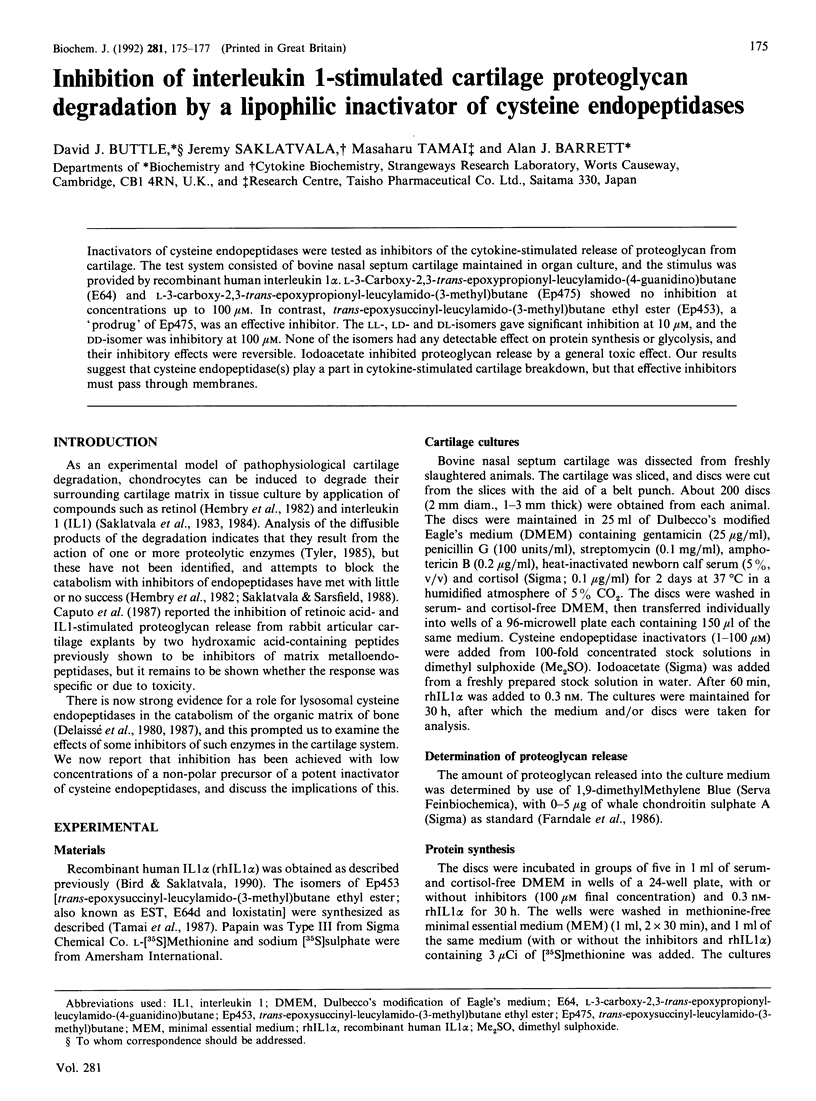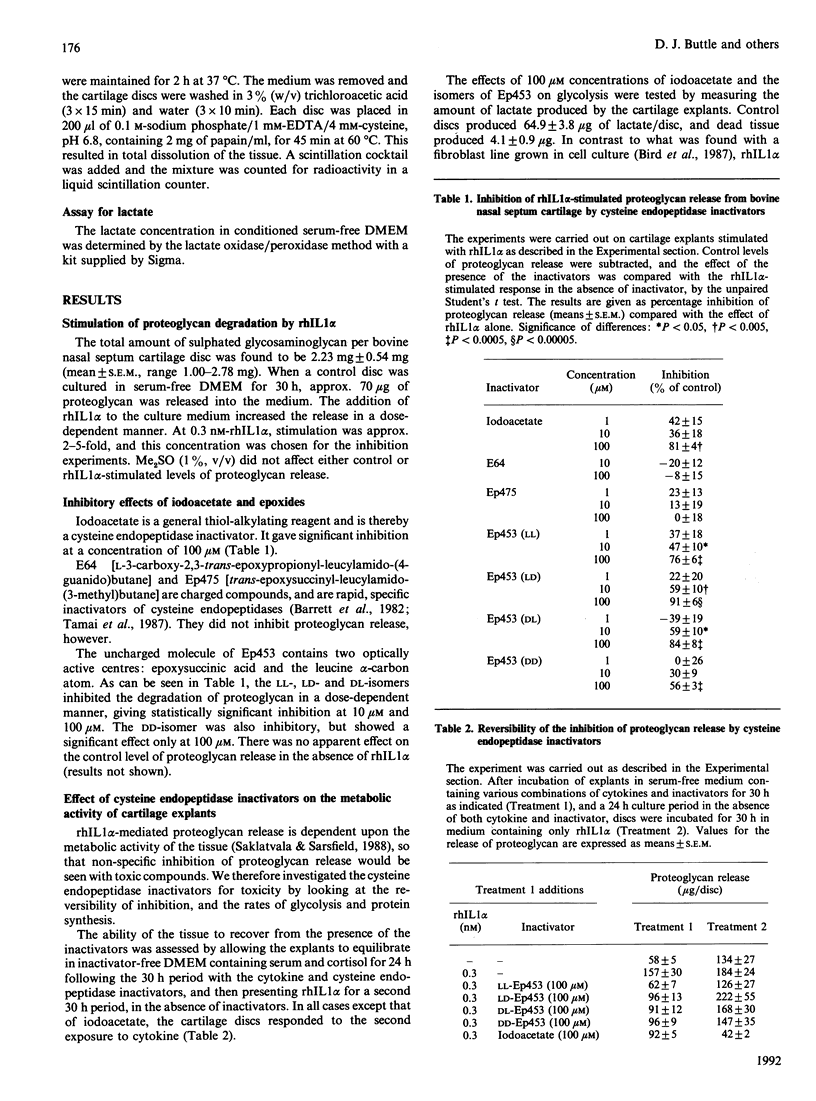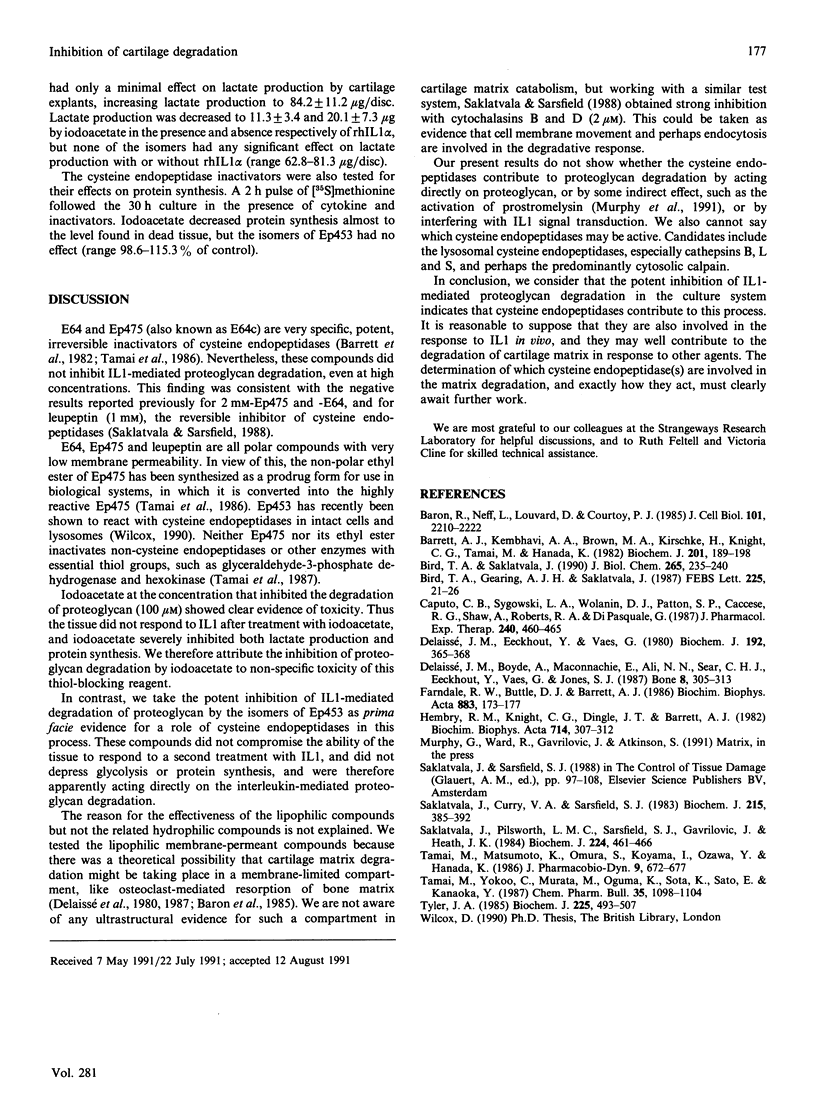Abstract
Inactivators of cysteine endopeptidases were tested as inhibitors of the cytokine-stimulated release of proteoglycan from cartilage. The test system consisted of bovine nasal septum cartilage maintained in organ culture, and the stimulus was provided by recombinant human interleukin 1 alpha. L-3-Carboxy-2,3-trans-epoxypropionyl-leucylamido-(4-guanidin o)butane (E64) and L-3-carboxy-2,3-trans-epoxypropionyl-leucylamido-(3-methyl)b utane (Ep475) showed no inhibition at concentrations up to 100 microM. In contrast, trans-epoxysuccinyl-leucylamido-(3-methyl)butane ethyl ester (Ep453), a 'prodrug' of Ep475, was an effective inhibitor. The LL-, LD- and DL-isomers gave significant inhibition at 10 microM, and the DD-isomer was inhibitory at 100 microM. None of the isomers had any detectable effect on protein synthesis or glycolysis, and their inhibitory effects were reversible. Iodoacetate inhibited proteoglycan release by a general toxic effect. Our results suggest that cysteine endopeptidase(s) play a part in cytokine-stimulated cartilage breakdown, but that effective inhibitors must pass through membranes.
Full text
PDF


Selected References
These references are in PubMed. This may not be the complete list of references from this article.
- Baron R., Neff L., Louvard D., Courtoy P. J. Cell-mediated extracellular acidification and bone resorption: evidence for a low pH in resorbing lacunae and localization of a 100-kD lysosomal membrane protein at the osteoclast ruffled border. J Cell Biol. 1985 Dec;101(6):2210–2222. doi: 10.1083/jcb.101.6.2210. [DOI] [PMC free article] [PubMed] [Google Scholar]
- Barrett A. J., Kembhavi A. A., Brown M. A., Kirschke H., Knight C. G., Tamai M., Hanada K. L-trans-Epoxysuccinyl-leucylamido(4-guanidino)butane (E-64) and its analogues as inhibitors of cysteine proteinases including cathepsins B, H and L. Biochem J. 1982 Jan 1;201(1):189–198. doi: 10.1042/bj2010189. [DOI] [PMC free article] [PubMed] [Google Scholar]
- Bird T. A., Gearing A. J., Saklatvala J. Murine interleukin-1 receptor: differences in binding properties between fibroblastic and thymoma cells and evidence for a two-chain receptor model. FEBS Lett. 1987 Dec 10;225(1-2):21–26. doi: 10.1016/0014-5793(87)81124-9. [DOI] [PubMed] [Google Scholar]
- Bird T. A., Saklatvala J. Down-modulation of epidermal growth factor receptor affinity in fibroblasts treated with interleukin 1 or tumor necrosis factor is associated with phosphorylation at a site other than threonine 654. J Biol Chem. 1990 Jan 5;265(1):235–240. [PubMed] [Google Scholar]
- Caputo C. B., Sygowski L. A., Wolanin D. J., Patton S. P., Caccese R. G., Shaw A., Roberts R. A., DiPasquale G. Effect of synthetic metalloprotease inhibitors on cartilage autolysis in vitro. J Pharmacol Exp Ther. 1987 Feb;240(2):460–465. [PubMed] [Google Scholar]
- Delaisse J. M., Boyde A., Maconnachie E., Ali N. N., Sear C. H., Eeckhout Y., Vaes G., Jones S. J. The effects of inhibitors of cysteine-proteinases and collagenase on the resorptive activity of isolated osteoclasts. Bone. 1987;8(5):305–313. doi: 10.1016/8756-3282(87)90007-x. [DOI] [PubMed] [Google Scholar]
- Delaissé J. M., Eeckhout Y., Vaes G. Inhibition of bone resorption in culture by inhibitors of thiol proteinases. Biochem J. 1980 Oct 15;192(1):365–368. doi: 10.1042/bj1920365. [DOI] [PMC free article] [PubMed] [Google Scholar]
- Farndale R. W., Buttle D. J., Barrett A. J. Improved quantitation and discrimination of sulphated glycosaminoglycans by use of dimethylmethylene blue. Biochim Biophys Acta. 1986 Sep 4;883(2):173–177. doi: 10.1016/0304-4165(86)90306-5. [DOI] [PubMed] [Google Scholar]
- Hembry R. M., Knight C. G., Dingle J. T., Barrett A. J. Evidence that extracellular cathepsin D is not responsible for the resorption of cartilage matrix in culture. Biochim Biophys Acta. 1982 Feb 2;714(2):307–312. doi: 10.1016/0304-4165(82)90338-5. [DOI] [PubMed] [Google Scholar]
- Saklatvala J., Curry V. A., Sarsfield S. J. Purification to homogeneity of pig leucocyte catabolin, a protein that causes cartilage resorption in vitro. Biochem J. 1983 Nov 1;215(2):385–392. doi: 10.1042/bj2150385. [DOI] [PMC free article] [PubMed] [Google Scholar]
- Saklatvala J., Pilsworth L. M., Sarsfield S. J., Gavrilovic J., Heath J. K. Pig catabolin is a form of interleukin 1. Cartilage and bone resorb, fibroblasts make prostaglandin and collagenase, and thymocyte proliferation is augmented in response to one protein. Biochem J. 1984 Dec 1;224(2):461–466. doi: 10.1042/bj2240461. [DOI] [PMC free article] [PubMed] [Google Scholar]
- Tamai M., Matsumoto K., Omura S., Koyama I., Ozawa Y., Hanada K. In vitro and in vivo inhibition of cysteine proteinases by EST, a new analog of E-64. J Pharmacobiodyn. 1986 Aug;9(8):672–677. doi: 10.1248/bpb1978.9.672. [DOI] [PubMed] [Google Scholar]
- Tamai M., Yokoo C., Murata M., Oguma K., Sota K., Sato E., Kanaoka Y. Efficient synthetic method for ethyl (+)-(2S,3S)-3-[(S)-3-methyl- 1-(3-methylbutylcarbamoyl)butylcarbamoyl]-2-oxiranecarb oxylate (EST), a new inhibitor of cysteine proteinases. Chem Pharm Bull (Tokyo) 1987 Mar;35(3):1098–1104. [PubMed] [Google Scholar]
- Tyler J. A. Chondrocyte-mediated depletion of articular cartilage proteoglycans in vitro. Biochem J. 1985 Jan 15;225(2):493–507. doi: 10.1042/bj2250493. [DOI] [PMC free article] [PubMed] [Google Scholar]


